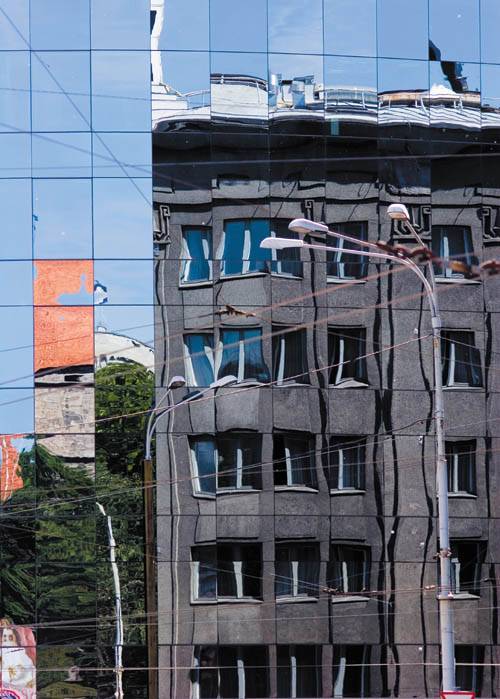Chapter 1. Getting Started
| Building reflection, Talimm, Estonia, 2005. 1/200 s at 4/5.6. Canon EOS 20D with Canon 75-300mm EF lens.
In April 1991, the Galileo space probe was picking its way through the main asteroid belt that lies between Mars and Jupiter, roughly 250 million miles from Earth. The 22-foot-long space probe had been sent to explore Jupiter and its complex system of moons and was packed with a number of high-tech instruments, including spectrometers, magnetometers, radiometers, a heavy ion counter, energy particle detectors, and a digital camera. Unfortunately, Galileo (along with dozens of NASA engineers) was having a very bad day. Because of a mechanical failure, the ship's main antenna was stuck and unable to completely deploy. Though Galileo had a secondary antenna, it was capable of transmitting only a tiny fraction of the information that could be sent using the primary antenna. While the main antenna packed enough bandwidth to transmit one high-resolution image per minute, the secondary antenna would be able to manage only one high-res image per month. Without the main antenna, almost all of the data and pictures the probe would capture would simply have to be deletedit would be lost forever because there was no way to send any of it home. NASA never did recover the main antennait remained broken and useless for the remaining 12 years of the craft's mission, until it was finally destroyed along with the rest of ship when NASA controllers intentionally crashed the Galileo probe into Jupiter's atmosphere. Thanks to some clever software work, though, the mission was a raging success. The problem was that the pictures the probe was trying to send were too big for the secondary antenna to deal with, given its limited bandwidth capability. Obviously, there was no way to replace the antenna from 250 million miles away. However, back on Earth, there had been some important technological advances since the ship's original computer design was frozen. In those intervening years, sophisticated image compression had been developed. Technologies akin to JPEGthe technology used by your web browser or digital camera to compress digital imagescould be employed to greatly reduce the size of Galileo's images, allowing them to fit through the secondary antenna's limited-bandwidth pipe. Though Galileo's computer was equivalent to a 1970s-era Pong machine, NASA programmers managed to craft image compression software that would allow the computer to work more effectively with its less capable antenna. After several years of recoding, and with no second chance available (you can't reboot a space ship from a floppy if you screw up its computer), they uploaded the new, radically different software. To their tremendous joy, everything worked perfectly. Galileo was able to complete 75 percent of its planned mission and made many discoveries and tests that were not part of its original mission plan. Digital cameras, whether on a space ship or in your camera bag, work by capturing some very fundamental grayscale data, which is then processed by the camera's on-board computer to produce a full-color image. The software inside the camera is used to determine everything from what color a pixel should be, to how much sharpening should be applied, to how the data should be compressed so that it can fit onto your storage card (or through a radio transmitter aimed at a far-away planet). Because this processing step is crucial to getting a finished image, the quality of your camera's processing software has a huge bearing on your final image. In the case of Galileo, NASA was able to replace the probe's imaging software with something better. Similarly, NASA scientists often reprocess image data to create special "false-color images" that reveal types of information not normally visible in a true-color image. The process of shooting raw with your digital camera works exactly the same way. When you shoot raw, your camera stores the very fundamental data that its image sensor collects, without doing any image processing at all. Later, you use special software on your desktop computer to process the raw image datawhich appears pretty weird if you look at it directlyinto a full-color, finished image. Shooting raw has several advantages over shooting in TIFF or JPEG format:
The downside to raw is that it requires one or two extra steps that you don't have to worry about with JPEG. If you're shooting simple snapshots, then you'll have an easier time going from the camera to the web or print with JPEG files. But if you're planning on doing any editing of your images or are shooting in conditions that might confound your camera's automatic features, then raw is a much better way to work. |
EAN: 2147483647
Pages: 76
